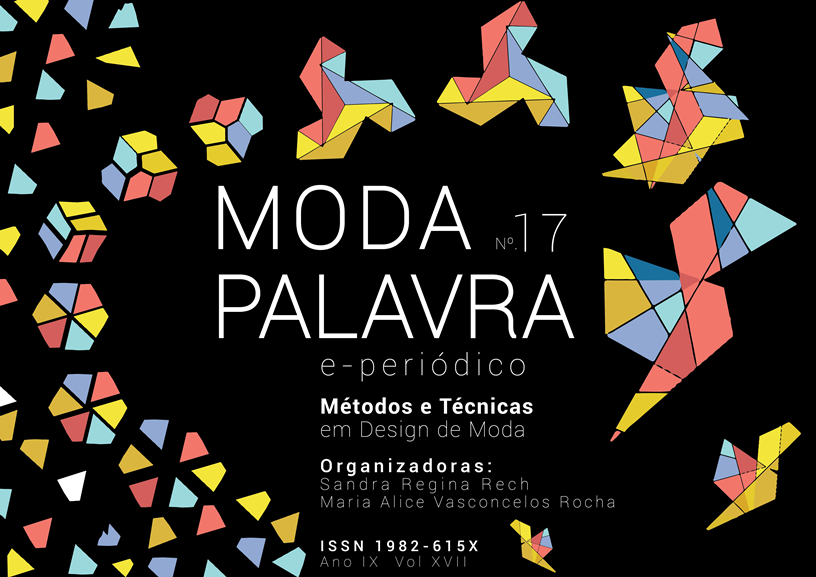Coolhunting and trends studies applied to fashion: strategic segmentation model
DOI:
https://doi.org/10.5965/1982615x09172016006Keywords:
trends studies, coolhunting, fashion systemAbstract
The present paperexplores new methodologies and concepts that can help in the development of fashion products and brands. For such, we underline the importance of Trends Studies and Coolhunting, which provide insights on new consumer behaviors and mindsets. The traditional approaches to the fashion system reveal a complex phenomenon where behind the object, meaning the visible manifestation of fashion,exists a symbolic construction and power relation that originates new patterns and tastes.This work begins by approachingthe fashion system, in order to proceed to Coolhunting and Fashion Studies. The objective is to present an application model based on Trends Studies for the fashion industry, with a focus on the potential for group and audience segmentation.
Downloads
References
BARNARD, Malcolm (2002). Fashion as Communication. London: Routledge.
BARTHES, Roland (1999) [1967]. Sistema da Moda. Tradução de Maria de Santa Cruz, Lisboa: Edições 70.
BAUDRILLARD, Jean (1998). Symbolic Exchange and Death. Tradução de Iain Hamilton Grant. Londres: Sage.
BLACKMORE, Susan (1999). The Meme Machine. Oxford: Oxford University Press.
BLUMER, Herbert (1969). ―Fashion –From Class Differentiation to Collective Selection‖in Sociological Quaterly 10.
CRANE, Diana (2001).Fashion and its Social Agendas.Chicago: University of Chicago Press.
BORDIEU, Pierre (2006) [1979]. A Distinção: Crítica Social do Julgamento.Traduzido por Daniela Kern e Guilherme Teixeira. São Paulo: Edições Zouk.
BOURDIEU, Pierre (1989).O Poder Simbólico. Tradução de Fernando Tomaz, Algés: Difusão Editorial, S.A.
DAWKINS, Richard (1989). O Gene Egoísta. Tradução de Ana Paula Oliveira, Lisboa: Gradiva.
DENNETT, Daniel (1993). Consciouness Explained. Penguin Books.
ELIADE, Mircea (1963). Aspectos do Mito.Tradução de Manuela Torres, Lisboa: Edições 70.
DORFLES, Gillo (1990). Modas & Modos. Tradução de J. Pinto Ribeiro, Lisboa: Edições 70.
GLOOR, Peter e Scott Cooper (2007). Coolhunting: Chasing down the next big thing. New York: Amacom.
GOMES, Nelson P. (2014). ―Branding de Moda na Hipermodernidade Líquida‖ in Revista Portuguesa de Marketing, nº 32, pp. 9-19.
LIPOVETSKY, Gilles (2010a). A Felicidade Paradoxal.Tradução de Patrícia Xavier, Lisboa: Ed.70.
LIPOVETSKY, Gilles; SERROY, Jean (2010b). A Cultura-Mundo. Resposta a uma sociedade desorientada. Tradução de Victor Silva, Lisboa: Edições 70.
HIGHAM, William (2009). The Next Big Thing. London: Kogan Page.
RAYMOND, Martin (2010). The Trend Forecaster ́s Handbook. London: Laurence King.
SAPIR, Edward (1949). ―Fashion‖, in Selected Writings of Edward Sapir, ed. David Mandelbaum. Pp. 373-381. Berkeley: University of California Press.
SAUSSURE, Ferdinand (2006). Course in general linguistics. Tradução de Roy Harris, Illinois: Open Court Publishing.
SIMMEL, Georg (1957) [1904]. ―Fashion‖ inAmerican Journal of Sociology, pp. 541-558.
VEJLGAARD, Henrik (2008). Anatomy of a Trend. New York: McGraw-Hill.
ZIPES, Jack (2006). Why fairy tales stick: The evolution and relevance of a genre. New York: Routledge.
Downloads
Published
How to Cite
Issue
Section
License
Copyright (c) 2015 Nelson Gomes, Maria Vieira Lopes, Paulo Emanuel Alves

This work is licensed under a Creative Commons Attribution-NonCommercial 4.0 International License.
When submitting an article for publication in ModaPalavra e-periodico, the author (s) agree (s) with the following terms:
- Authors maintain the copyright in their manuscripts and grant the journal the right of first publication, with work simultaneously licensed under the Creative Commons Attribution-NonCommercial 4.0 International, which allows sharing the work with the acknowledgment of authorship and the initial publication in the journal without payment ;
- Authors may use the same results in other publications after the first publication, provided that they indicate ModaPalavra e-journal as the original publication medium;
- Authors are authorized to take additional contracts, separately, only after the original publication in ModaPalavra e-journal, provided they indicate ModaPalavra e-journal as the original publication medium;
- Authors are allowed and encouraged to publish and distribute their work online (eg in institutional repositories or on their personal page), only after the editorial process and the first publication, provided they indicate ModaPalavra e-journal as the original publication medium;
- To indicate ModaPalavra e-journal as the original publication medium, authors should use the following text template: "This article was originally published by ModaPalavra e-periodical, under a CC BY NC license, in its volume [insert volume] number [insert number] in the year of [insert year], and can be accessed at: http://www.revistas.udesc.br/index.php/modapalavra/ ";
- The opinions expressed in the articles are the author’s sole responsibility, not necessarily reflecting the journal’s opinion. The publication of any material that is owned and held in copyright by a third party, including – but not limited to - articles, photos or drawings was previously authorized by their representatives to be published in ModaPalavra e-journal.









